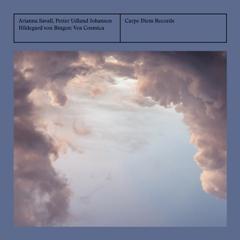Hildegard von Bingen – Vox cosmica (2014)
Hildegard von Bingen – Vox cosmica (2014)

1. Hildegard von Bingen (1098 – 1179) – Responsorium: O tu suavissima virga 15:14 2. Hildegard von Bingen – Antiphona: Karitas habundat 5:57 3. Petter Udland Johansen (*1971) – Meditation I 4:54 4. Petrus Abaelardus (1079 – 1142) – Sequentia: Planctus David 16:00 5. Petter Udland Johansen – Meditation II 4:09 6. Hildegard von Bingen – Responsorium: Ave Maria 10:26 7. Petter Udland Johansen – Meditation III 4:33 8. Hildegard von Bingen – Antiphona: O quam mirabilis 7:57 9. Petter Udland Johansen – Meditation IV 4:27 10. Hildegard von Bingen – Antiphona: O virtus Sapientie 6:21 Hirundo Maris: Arianna Savall – Voice, Medieval Harp, Italian Triple Harp, Lyra, Tibetan Singing Bowl Petter Udland Johansen – Voice, Hardingfele, Lyra, Fiddle, Monochord Andreas Spindler – Flutes, Fiddle, Romain Bells, Colascione, Tromba Marina, Voice Anke Spindler – Nyckelharpa, Fiddles, Viola da Gamba, Voice David Mayoral – Santur, Percussion, Romain Bells, Voice
To judge from the minimal graphics of this Carpe Diem release, soprano Arianna Savall doesn't have quite the skills of her famous father, Jordi, at wrangling support from the Catalonian government for lavish six-language booklets. It's too bad, for what Savall and her accompanying group, Hirundo Maris, offer here is a novel approach to the music of the medieval German abbess Hildegard von Bingen. Chant singing is essentially a group activity, but the expressivity of Hildegard's compositions, with their wide melodic ranges and distinctive original poetry, has inspired more subjective approaches with solo singing. This is all to the good as long as listeners realize that what they're getting is not a historically informed performance. Indeed, Hirundo Maris contains a mix of instruments gleefully ranging from the Persian santur to the Scandinavian nyckelharpa, deployed so as to generate shimmering, shifting textures thought to complement the spirituality of the texts. An especially inspired if totally ahistorical addition is a Tibetan singing bowl, used to produce an attractive drone note. Savall's voice will not disappoint those who've heard her on Jordi Savall's recordings, and she seems to react genuinely to Hildegard's ecstatic poetry. There are some instrumental compositions by ensemble co-founder Petter Udland Johansen that try to evoke the general mood of Hildegard's music; because they add percussion and are not really consistent in tonal material, they tend to break that mood. And the addition of a piece by Petrus Abelardus (the Abelard in Abelard and Heloise) also seems out of place, although it does set off Hildegard's distinctive style. Recommended for fans of the Savall clan and for those interested in novel approaches to medieval music. ---James Manheim, AllMusic Review
download (mp3 @320 kbs):
yandex mediafire uloz.to mega 4shared cloudmailru gett








